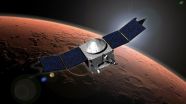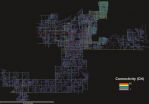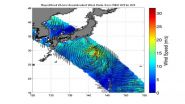(Press-News.org) Two NASA and one European spacecraft, including NASA's MAVEN mission led by the University of Colorado Boulder, have gathered new information about the basic properties of a wayward comet that buzzed by Mars Oct. 19, directly detecting its effects on the Martian atmosphere.
Data from observations carried out by MAVEN, NASA's Mars Reconnaissance Orbiter (MRO) and the European Space Agency's Mars Express spacecraft revealed that debris from the comet, known officially as Comet C/2013 A1 Siding Spring, caused an intense meteor shower and added a new layer of ions, or charged particles, to the ionosphere. The ionosphere is an electrically charged region in the atmosphere that reaches from about 75 miles (120 kilometers) to several hundred miles above the Martian surface.
Using the observations, scientists were able to make a direct connection between the input of debris from the meteor shower to the subsequent formation of the transient layer of ions - the first time such an event has been observed on any planet, including Earth, said the MAVEN research team.
The comet traveled from the most distant region of our solar system called the Oort Cloud and made a close approach at 2:27 p.m. EDT within about 87,000 miles (139,500 kilometers) of the Red Planet. That is less than half the distance between Earth and our moon and less than one-tenth the distance of any known comet flyby of Earth.
"MAVEN is well suited for studying the effects of the dust from the comet in the Martian atmosphere, because it makes measurements at the altitudes where the dust was expected to have an effect," said CU-Boulder Professor Bruce Jakosky of the Laboratory for Atmospheric and Space Physics, the principal investigator on the $671 million Mars Atmosphere and Volatile EvolutioN (MAVEN) mission. "We also should be able to see if there are long-term effects from the comet dust in that same region of the atmosphere."
Dust from the comet was vaporized high in the Martian atmosphere, producing what was likely an impressive meteor shower. The debris resulted in significant but temporary changes to the planet's upper atmosphere and possible longer-term changes. A host of Earth-based and orbiting telescopes also observed the unique celestial event.
The MAVEN spacecraft, recently arrived at Mars, detected the comet encounter in two ways. The remote-sensing Imaging Ultraviolet Spectrograph (IUVS) designed and built at CU-Boulder observed intense ultraviolet emissions from magnesium and iron ions high in the atmosphere in the aftermath of the meteor shower. Not even the most intense meteor storms on Earth have produced as strong a response as this one: The emission dominated Mars' ultraviolet spectrum for several hours after the encounter and then dissipated over the next two days, according to the MAVEN science team.
MAVEN also was able to directly sample and help scientists determine the composition of some of the vaporized comet dust in Mars' atmosphere. Analysis of these samples by the spacecraft's Neutral Gas and Ion Mass Spectrometer designed and developed at NASA Goddard Space Flight Center in Greenbelt, Maryland, detected eight different types of metal ions, including sodium, magnesium and iron.
These are the first direct measurements of the composition of dust from an Oort Cloud comet. The Oort Cloud, well beyond the outermost planets that surround our sun, is a spherical region of icy objects believed to be material left over from the formation of the solar system.
"They call this comet encounter a once-in-a-lifetime event, but it's more like once-in-a-million years," said CU-Boulder Associate Professor Nick Schneider, a LASP research associate and lead IUVS scientist for the mission. "MAVEN got there just in time, and we were ready. The numbers suggest a Martian would have seen many thousands of shooting stars per hour -- possibly enough to be called a meteor storm -- so it must have been a spectacular event that night on Mars."
Elsewhere above Mars, a joint U.S. and Italian instrument on Mars Express observed a huge increase in the density of electrons in the Martian ionosphere following the comet's close approach.
"This historic event allowed us to observe the details of this fast moving Oort Cloud comet in a way never before possible using our existing Mars missions," said Jim Green, director of NASA's Planetary Science Division at the agency's headquarters in Washington. "Observing the effects on Mars of the comet's dust slamming into the upper atmosphere makes me very happy that we decided to put our spacecraft on the other side of Mars at the peak of the dust tail passage and out of harms way."
There are three CU-Boulder undergraduates and two graduate students on the IUVS science team, said Schneider, and there will be a number of additional CU-Boulder students working on MAVEN in the coming years. Currently there are more than 100 students working on research projects at LASP, which provides hands-on training for future careers as engineers and scientists.
In addition to leading science operations, CU-Boulder is spearheading education and public outreach for MAVEN mission, which has contributed roughly $300 million to Colorado's economy. UC-Berkeley's Space Sciences Laboratory provided four science instruments for the mission.
INFORMATION:
NASA's Goddard Space Flight Center manages the mission. NASA's Jet Propulsion Laboratory, a division of Caltech in Pasadena, manages the Mars Reconnaissance Orbiter.
For more information about NASA's Mars missions visit http://www.nasa.gov/mars. For more information on MAVEN visit http://lasp.colorado.edu/home/maven/.
-CU-
Contact:
Bruce Jakosky, 303-492-8004
bruce.jakosky@lasp.colorado.edu
Nick Schneider, 303-492-7672
nick.schneider@lasp.colorado.edu
Jim Scott, CU-Boulder media relations, 303-492-3114
jim.scott@colorado.edu
Mars spacecraft, including MAVEN, reveal comet flyby effects on Martian atmosphere
If there were Martians, they likely would have witnessed thousands of shooting stars from Comet Siding Spring, according to CU-Boulder scientist
2014-11-07
ELSE PRESS RELEASES FROM THIS DATE:
NFL TV ratings: Bandwagon is everyone's second-favorite team
2014-11-07
A new study by Brigham Young University and the Fox affiliate in Salt Lake City shows that choosing to broadcast a local favorite isn't always the smartest ratings decision.
The new study shows how TV execs should decide which games to air when the home-town team isn't playing - or in markets like Utah that don't have their own team. Traditionally the most popular teams in Utah have been the Broncos, Cowboys and 49ers.
"When you look at the difference between the average team effect, like say the Miami Dolphins, and the next top tier after the Denver Broncos, the results ...
Reprogrammed cells grow into new blood vessels
2014-11-07
HOUSTON -- ( Nov. 7, 2014 ) -- By transforming human scar cells into blood vessel cells, scientists at Houston Methodist may have discovered a new way to repair damaged tissue. The method, described in an upcoming issue of Circulation (early online), appeared to improve blood flow, oxygenation, and nutrition to areas in need.
Cardiovascular scientists at Houston Methodist, with colleagues at Stanford University and Cincinnati Children's Hospital, learned that fibroblasts -- cells that causes scarring and are plentiful throughout the human body -- can be coaxed into becoming ...
Research shows easy-to-walk communities can blunt cognitive decline
2014-11-07
LAWRENCE -- New study results from the University of Kansas to be presented this weekend at the Gerontological Society of America's annual meeting in Washington, D.C., bolster the adage that "heart healthy is brain healthy." The investigation shows neighborhoods that motivate walking can stave off cognitive decline in older adults.
"People can walk either to get somewhere or for leisure," said Amber Watts, assistant professor of clinical psychology, who will share her findings at a symposium Sunday, Nov. 9, in Liberty Salon K at the Washington Marriott Marquis.
"Depending ...
Cybersecurity experts discover lapses in Heartbleed bug fix
2014-11-07
A detailed analysis by cybersecurity experts from the University of Maryland found that website administrators nationwide tasked with patching security holes exploited by the Heartbleed bug may not have done enough.
First disclosed in April 2014, Heartbleed presents a serious vulnerability to the popular OpenSSL (Secure Sockets Layer) software, allowing anyone on the Internet to read the memory of systems that are compromised by the malicious bug.
Assistant Research Scientist Dave Levin and Assistant Professor of Electrical and Computer Engineering Tudor Dumitras were ...
Researchers take new approach to stop 'Most Wanted' cancer protein
2014-11-07
BOSTON (November 7, 2014) -- Researchers at Dana-Farber/Boston Children's Cancer and Blood Disorders Center have found a way to defeat one of the most tantalizing yet elusive target proteins in cancer cells - employing a strategy that turns the protein's own molecular machinations against it.
In a study published online by the journal Cell, the scientists used a specially crafted compound to disrupt the protein's ability to rev up its own production and that of other proteins involved in tumor cell growth. The result, in laboratory samples of neuroblastoma cancer cells ...
NASA eyes Post-Tropical Storm Nuri's winds, now to affect Alaska
2014-11-07
NASA's newest Earth observing mission, the International Space Station-Rapid Scatterometer, or ISS-RapidScat provided a look at the winds within post-tropical cyclone Nuri on Nov. 5 and 6 as it moved parallel to Japan. Nuri has moved across the Pacific and is expected to bring hurricane-force wind gusts to Alaska's Aleutian Islands today, Nov. 7.
"RapidScat passed over Nuri, near Japan, three times within a 24 hour period," said Doug Tyler of NASA's Jet Propulsion Laboratory, Pasadena, California. "The progression [in three images] showed Nuri's path."
RapidScat measured ...
Workplace health programs are key to improving american life expectancy and health
2014-11-07
New York - As Americans face growing health and financial burdens from preventable, non-communicable diseases such as cardiovascular disease, diabetes and certain cancers, a new study demonstrates employers have a unique opportunity to improve Americans' health. The research is led by Dr. Katherine Tryon and Dr. Derek Yach from the Vitality Institute and is published in the November issue of the Journal of Occupational and Environmental Medicine.
The study, which involved a first-of-its-kind comprehensive review of existing research into workplace health programs, notes ...
A vaccine directed against tumor blood vessels suppress tumor growth and metastasis
2014-11-07
In a new study published in the scientific journal Oncotarget researchers from Uppsala University show that a therapeutic vaccine directed against tumor vessels can reduce tumor burden and suppress formation of spontaneous lung metastases in a mouse model for metastatic breast cancer.
The target molecule of the immunization strategy is the extra domain-A (ED-A) of fibronectin, a protein domain which is highly selective for the tumor vasculature in the adult.
"The vaccination approach we have employed is not prophylactic but therapeutic, meaning that immunity was induced ...
NASA-NOAA's Suomi NPP satellite sees Tropical Cyclone 05B headed to India
2014-11-07
Tropical Cyclone 05B was meandering in the Bay of Bengal on Nov. 8, but forecasters expect it to move west and head toward east-central India for landfall. NASA-NOAA's Suomi NPP satellite captured a visible image of the tropical storm off India's coast.
When Suomi NPP flew over Tropical Cyclone 05B (TC05B) on Nov. 7 at 08:09 UTC (3:09 a.m. EST), the Visible Infrared Imaging Radiometer Suite or VIIRS instrument aboard captured a visible image of the storm. The VIIRS image showed a band of thunderstorms wrapping into the center from the northern quadrant, and fragmented ...
Actions versus objects: The role of the motor system
2014-11-07
Amyotrophic lateral sclerosis (ALS) is a very severe disease that mainly affects the motor system. Recently the focus of public attention thanks to a viral campaign (remember last summer's ALS Ice Bucket Challenge?), ALS leads to progressive paralysis and ultimately death. Among the lesser known symptoms of the disease are cognitive impairments, which may even involve full-blown dementia. One of them is a selective difficulty in understanding and using verbs denoting actions, which these patients find much more challenging to process compared to nouns denoting objects. ...
LAST 30 PRESS RELEASES:
First ‘Bible map’ published 500 years ago still influences how we think about borders
Why metabolism matters in Fanconi anemia
Caribbean rainfall driven by shifting long-term patterns in the Atlantic high-pressure system, study finds
Potential treatment to bypass resistance in deadly childhood cancer
RSV vaccines could offer protection against asthma
Group 13 elements: the lucky number for sustainable redox agents?
Africa’s forests have switched from absorbing to emitting carbon, new study finds
Scientists develop plastics that can break down, tackling pollution
What is that dog taking? CBD supplements could make dogs less aggressive over time, study finds
Reducing human effort in rating software
Robots that rethink: A SMU project on self-adaptive embodied AI
Collaborating for improved governance
The 'black box' of nursing talent’s ebb and flow
Leading global tax research from Singapore: The strategic partnership between SMU and the Tax Academy of Singapore
SMU and South Korea to create seminal AI deepfake detection tool
Strengthening international scientific collaboration: Diamond to host SESAME delegation from Jordan
Air pollution may reduce health benefits of exercise
Ancient DNA reveals a North African origin and late dispersal of domestic cats
Inhibiting a master regulator of aging regenerates joint cartilage in mice
Metronome-trained monkeys can tap to the beat of human music
Platform-independent experiment shows tweaking X’s feed can alter political attitudes
Satellite data reveal the seasonal dynamics and vulnerabilities of Earth’s glaciers
Social media research tool can lower political temperature. It could also lead to more user control over algorithms.
Bird flu viruses are resistant to fever, making them a major threat to humans
Study: New protocol for Treg expansion uses targeted immunotherapy to reduce transplant complications
Psychology: Instagram users overestimate social media addiction
Climate change: Major droughts linked to ancient Indus Valley Civilization’s collapse
Hematological and biochemical serum markers in breast cancer: Diagnostic, therapeutic, and prognostic significance
Towards integrated data model for next-generation bridge maintenance
Pusan National University researchers identify potential new second-line option for advanced biliary tract cancer
[Press-News.org] Mars spacecraft, including MAVEN, reveal comet flyby effects on Martian atmosphereIf there were Martians, they likely would have witnessed thousands of shooting stars from Comet Siding Spring, according to CU-Boulder scientist






